Assembly Instructions: Kits #1-4
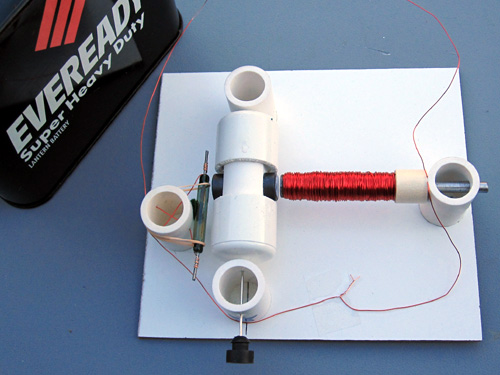
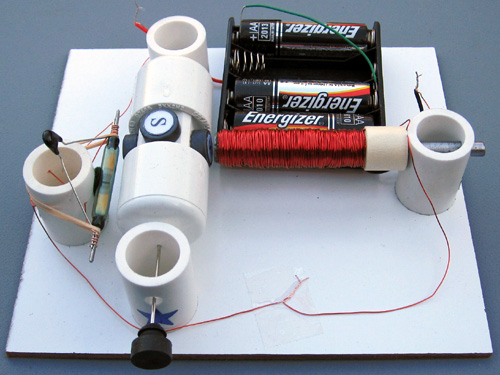
Difficulty level: 1 (the simplest, no special tools required)
Parts included in these kits: Kit #1, Kit #2, Kit #3, Kit #4
![]() Printer-friendly assembly instructions in pdf format.
Printer-friendly assembly instructions in pdf format.
If you want to purchase one of these inexpensive and simplest kits, click here.
If you want to understand how it works, click here.
Read all instructions carefully and check the Safety Rules before you start!
Instructions
- Insert the T-pin into one of the caps.
- Insert the rotor core into the same cap as shown below. Apply some pressure to push the rotor core approximately 1/2" (10-12mm) into the cap.
- Put in the wooden insert.
- Insert the pushpin into the other cap.
- Put everything together as shown below. Push the caps towards each other until they cannot move any more. The T-pin must be secured firmly. This process may require some strength. Be careful not to bend the T-pin or poke yourself.
- Glue the magnets to the flat
surfaces of the rotor core with the letter ‘S’ facing outside. If you purchased the kit with 4 magnets and want to try 2 magnets first, glue them to
the opposite sides. Straighten the T-pin if necessary. You can check it by
spinning the rotor between your thumb and index finger. Again, be very
careful.
All kits have magnets with the South pole marked. If you want this side to look better you may cut out the white glossy round labels that are provided and paste them to the marked sides. You may do it before attaching the magnets to the rotor. It is recommended to use regular white glue or a glue stick on the labels for better results. - Insert the rotor into the stands marked with blue and silver stars as shown below. Hold the stands and test to see if rotor spins freely. Make final adjustments to the T-pin if necessary.
- Glue the stand with the silver star to the board. Try to cover the corresponding star completely. Align the marks on the stand with the line on the board as shown below. Note that the star's position and the marks are approximate, sometimes you need to move the stands slightly to achieve the lowest friction. Keep in mind that super glue bonds instantly, so try to be as accurate as possible in these procedures.
- Insert the rotor into the stand marked with the blue star. Glue it to the board the same way as the first stand. Leave a gap of about 1/16" (1/32", or 0.8mm on each side) between the rotor and the stands. Test again to see if the rotor spins freely. At this time, or later, you may take the rubber plug and fix it as shown below. You can glue different things to the outer flat surface of the plug. Try to be accurate, redo this step if necessary.
- If you purchased the experimentation kit #2 or #3, instead of steps 10-12 for this
kit, follow these instructions. After that,
please, come back to this page and continue the assembly instructions from
step 13.
Otherwise, insert the nail into the stand with the green star. If it is loose you may apply glue as shown below. - Cut two pieces of wire 9"
(22-23cm) long**. Leave them for now - they will be used for connecting the reed switch. All remaining wire on the spool should be used to wrap around the area between the tape and the head of
the nail.
- Tape one end of wire leaving about 6" (15cm) open*. You may use the tape that is already on the nail.
- Wind all the wire in one rotational direction (either clockwise or counterclockwise) moving back and forth along the nail. Try to be as accurate as possible. Do not let the wire slide off the end of the electromagnet.
- Tape the second end of the wire using the same tape. Both open ends of wire should be about 6" (15cm) long*.
- Clean about
1" (2-3cm) of the wire tips with fine sandpaper (included) or a sharp
knife to remove the insulation.
* 10" (25cm) if your kit does not include a battery holder.
Test the electromagnet! Connect one wire to "+" and another wire to "-" of the battery. If electromagnet is assembled correctly the head of the nail should attract metal objects such as paper clips, small nails, knife blade, etc.
- Glue the electromagnet to the board as shown below. Turn the rotor slowly to see if the magnets hit the electromagnet. If one or more do, move the electromagnet back until there is a 1/16" (1.5mm) gap between the electromagnet and the closest magnet on the rotor.
- If you are assembling the Kit #8
please do steps 13-17 from Assembly Instructions: Reed
Switch Motor With Transistor instead. After that please come back to
this page and continue from step 18. For kits #1-4 follow these instructions:
Attach the self-sticking felt pad to the reed switch stand as shown. This soft pad decreases the reed switch vibration thus decreasing the sound it generates. - Take the two pieces of wire you cut earlier in step 11 and clean the wire tips to remove the insulation. Clean about 1 1/2" (4cm) on one end and 1/2" (12mm) on the other end of each wire piece. If you want to use ZNR go to step 15, otherwise wind longer bare ends tightly around outside contacts of the reed switch as shown in the first diagram. Insert the reed switch wires into its stand as shown in a second picture. Be careful not to break the reed switch, it is very fragile. Twist the wires as shown below in diagram 3.
- If you want to experiment with higher
voltages (up to 15 Volts) or make much more reliable motor you may add a ZNR.
The ZNR is a small electronic part that absorbs the spark inside the reed
switch. The ZNR is not required for the motor to work. Skip this step if you
are not adding ZNR at this time.
Wind longer bare wire ends tightly around outside contacts of the reed switch and the ZNR as shown in the first diagram. Insert the reed switch wires into its stand as shown in a second picture. Be careful not to break the reed switch, it is very fragile. Twist the wires as shown below in diagram 3. - Use rubber band to prevent the reed switch from moving.
- Glue the reed switch holder to the base. It should be located at a distance of about 1/8" (3mm) from the closest magnet covering the gold star on the board. Check the rotation of the rotor to make sure that it does not hit the reed switch. IMPORTANT: The most sensitive part of the reed switch is not in the middle of it, but more to the side as shown below. You should hear a clicking sound when each magnet passes by the reed switch, otherwise move the reed switch a little closer to the magnets until all four can turn the reed switch on.
- If your kit does not include a battery holder, skip this step. You will need to connect your motor to any 1.5-12 Volts DC power source. 6 Volts lantern battery is a good choice as they last longer and it is easy to connect them. You may see how this battery is connected in Assembly Instructions: Simple Motor You
Can Build Yourself.
Attach the battery holder to the board. The battery holder allows you to experiment with 4 different voltage settings (1.5, 3, 4.5, and 6V DC). You will need 4 AA size batteries.
To understand how the jumper wire works let's take a look at the connections inside the battery holder: - Before connecting everything together connect both wires from the electromagnet to the battery. If the electromagnet doesn’t repel the permanent magnets away, switch the wires. When it repels, disconnect one wire and connect it to the reed switch. Connect the other end of the reed switch to the battery. You may tape the wires to the board using scotch tape. The wiring diagram for kits #3 and #4 is shown below:

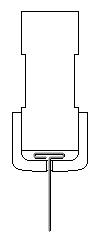



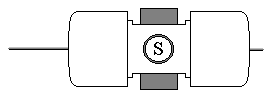
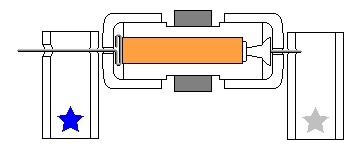

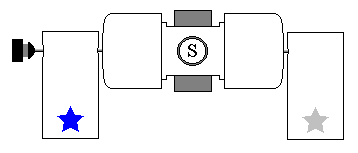
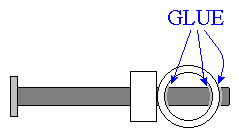
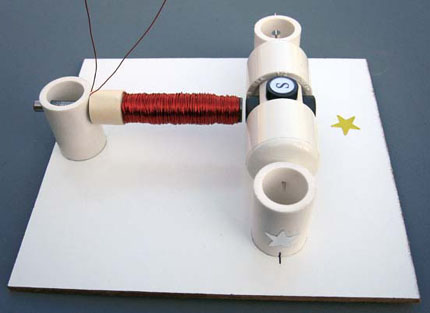


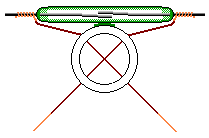
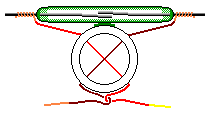

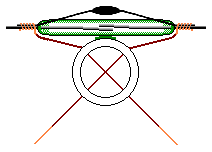
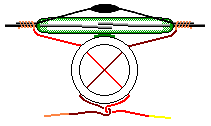
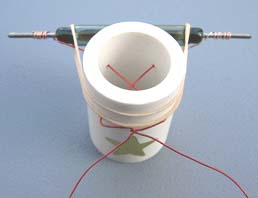
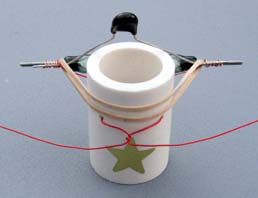
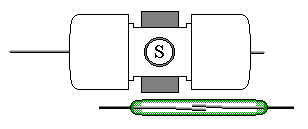
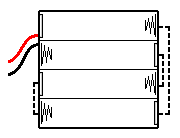
The following diagram shows how to get 1.5, 3, 4.5, and 6 Volts using 1, 2, 3, or 4 batteries and a jumper wire shown in blue color. Arrows show the current flow for 1.5, 3, and 4.5 Volts settings. Could you trace the current when all 4 batteries are inserted (there is no jumper wire in this case)?
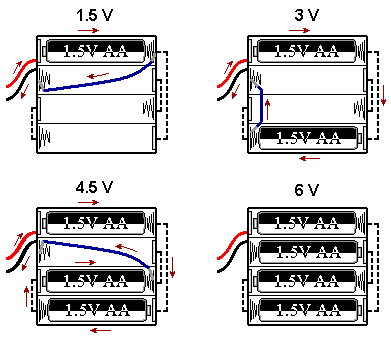
Insert bare ends of the jumper wire between the spring and plastic case to make a good contact and hold them in place. This is how the jumper wire is actually used for 1.5 Volts experiments (one end is disconnected and may serve as on/off switch):
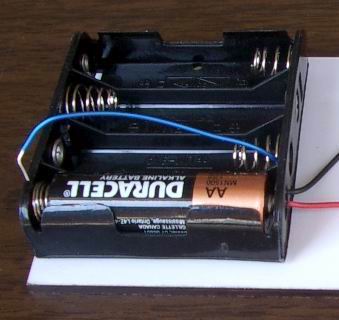
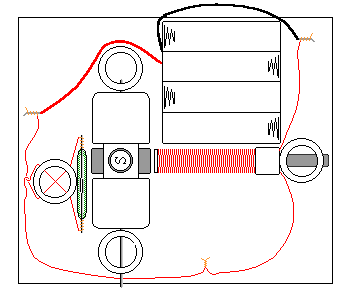
Start with 1.5V. If the motor does not work, increase the voltage to 3V. If it doesn’t help, ensure that the rotor rotates freely and check all the connections – it is
important to clean the insulation thoroughly. Make sure the batteries are fresh
and connected properly. If the motor still does not work – click here for troubleshooting.
It is easy to change and control
the speed of this motor with only a few additional parts. Experimentation kits allow you to add a
speed control unit and conduct other experiments.
CONGRATULATIONS! You have finished assembling
this electric motor! Click here for
Experiments and Applications.